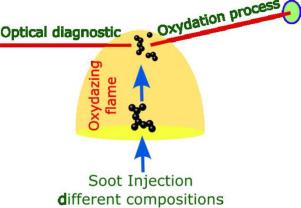Experimental investigation of the impact of organic contents and fuel (kerosene and SAF) on soot oxidation
IF 6.2
2区 工程技术
Q2 ENERGY & FUELS
引用次数: 0
Abstract
Soot oxidation is a critical process which directly impacts particulate emissions, yet remains insufficiently understood due to the complex interactions between surface growth and oxidation mechanisms. The present study isolates the oxidation from competing processes by using a two-stage burner configuration. By combining optical diagnostics, based on Phase Doppler Anemometry (PDA), Multiple Wavelength Thermal Emission (MTWE) and Multi-Angle Static Light Scattering (MASLS), the local flame temperature, velocity, soot volume fraction and particle size of soot experiencing oxidation are assessed. The impact of soot composition on oxidation efficiencies of particles generated from propane with different amount of organics, kerosene (Jet A-1) and Sustainable Aviation Fuel (SAF) is then investigated. The results reveal that, even under the same environmental conditions, significant differences in oxidation behavior across fuel types are observed. Surprisingly, in certain cases, mass reduction aligns with more effective agglomeration processes. This work, which considers the fractal nature of the soot aggregates, provides new expressions of oxidation rates for aeronautics fuels of interest thus giving precious inputs for numerical models allowing to understand aircraft emissions and to improve control strategies.
Novelty and Significance Statement
This study enhances the understanding of soot oxidation mechanisms by isolating oxidation from surface growth using a two-stage burner setup. Through various optical diagnostics, we assess the temporal evolution of soot temperature, volume fraction, and size, providing insights to improve numerical models predicting aeronautical emissions.
Examining the effects of soot organic composition and comparing fuels like Jet A-1 and Sustainable Aviation Fuel (SAF), we note significant differences in oxidation behaviors. This research aids in developing effective control strategies and supports the shift to cleaner fuels, advancing sustainable aviation.

有机成分和燃料(煤油和SAF)对煤烟氧化影响的实验研究
烟尘氧化是一个直接影响颗粒物排放的关键过程,但由于表面生长和氧化机制之间复杂的相互作用,人们对其知之甚少。本研究通过使用两级燃烧器配置将氧化从竞争过程中分离出来。结合光学诊断技术,基于相位多普勒风速法(PDA)、多波长热发射法(MTWE)和多角度静态光散射法(MASLS),评估了氧化过程中烟尘的局部火焰温度、速度、烟尘体积分数和粒径。研究了烟灰组成对含不同有机物量丙烷、煤油(Jet A-1)和可持续航空燃料(SAF)生成的颗粒氧化效率的影响。结果表明,即使在相同的环境条件下,不同燃料类型的氧化行为也存在显著差异。令人惊讶的是,在某些情况下,质量减少与更有效的团聚过程一致。这项工作考虑了煤烟聚集体的分形性质,为感兴趣的航空燃料提供了氧化率的新表达式,从而为数值模型提供了宝贵的输入,从而可以了解飞机排放并改进控制策略。新颖性和意义声明本研究通过使用两级燃烧器设置将氧化与表面生长隔离,从而增强了对烟灰氧化机制的理解。通过各种光学诊断,我们评估了烟灰温度、体积分数和大小的时间演变,为改进预测航空排放的数值模型提供了见解。研究了烟尘有机成分的影响,并比较了Jet A-1和可持续航空燃料(SAF)等燃料,我们注意到氧化行为的显著差异。这项研究有助于制定有效的控制策略,并支持向更清洁燃料的转变,促进可持续航空发展。
本文章由计算机程序翻译,如有差异,请以英文原文为准。
求助全文
约1分钟内获得全文
求助全文
来源期刊

Combustion and Flame
工程技术-工程:化工
CiteScore
9.50
自引率
20.50%
发文量
631
审稿时长
3.8 months
期刊介绍:
The mission of the journal is to publish high quality work from experimental, theoretical, and computational investigations on the fundamentals of combustion phenomena and closely allied matters. While submissions in all pertinent areas are welcomed, past and recent focus of the journal has been on:
Development and validation of reaction kinetics, reduction of reaction mechanisms and modeling of combustion systems, including:
Conventional, alternative and surrogate fuels;
Pollutants;
Particulate and aerosol formation and abatement;
Heterogeneous processes.
Experimental, theoretical, and computational studies of laminar and turbulent combustion phenomena, including:
Premixed and non-premixed flames;
Ignition and extinction phenomena;
Flame propagation;
Flame structure;
Instabilities and swirl;
Flame spread;
Multi-phase reactants.
Advances in diagnostic and computational methods in combustion, including:
Measurement and simulation of scalar and vector properties;
Novel techniques;
State-of-the art applications.
Fundamental investigations of combustion technologies and systems, including:
Internal combustion engines;
Gas turbines;
Small- and large-scale stationary combustion and power generation;
Catalytic combustion;
Combustion synthesis;
Combustion under extreme conditions;
New concepts.
 求助内容:
求助内容: 应助结果提醒方式:
应助结果提醒方式:


